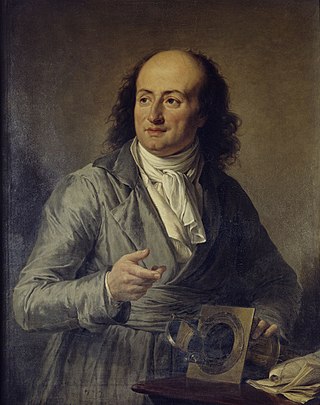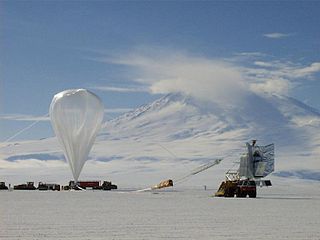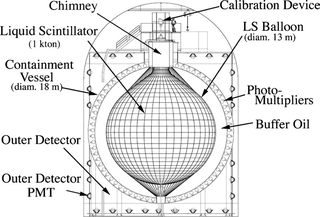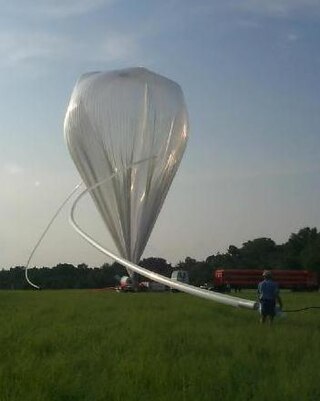This article needs additional citations for verification .(March 2024) |

BESS is a particle physics experiment carried by a balloon. BESS stands for Balloon-borne Experiment with Superconducting Spectrometer. [1]
This article needs additional citations for verification .(March 2024) |

BESS is a particle physics experiment carried by a balloon. BESS stands for Balloon-borne Experiment with Superconducting Spectrometer. [1]

An aerobot is an aerial robot, usually used in the context of an uncrewed space probe or unmanned aerial vehicle.

The antiproton,
p
, is the antiparticle of the proton. Antiprotons are stable, but they are typically short-lived, since any collision with a proton will cause both particles to be annihilated in a burst of energy.

A weather balloon, also known as a sounding balloon, is a balloon that carries instruments to the stratosphere to send back information on atmospheric pressure, temperature, humidity and wind speed by means of a small, expendable measuring device called a radiosonde. To obtain wind data, they can be tracked by radar, radio direction finding, or navigation systems. Balloons meant to stay at a constant altitude for long periods of time are known as transosondes. Weather balloons that do not carry an instrument pack are used to determine upper-level winds and the height of cloud layers. For such balloons, a theodolite or total station is used to track the balloon's azimuth and elevation, which are then converted to estimated wind speed and direction and/or cloud height, as applicable.

Jacques Alexandre César Charles was a French inventor, scientist, mathematician, and balloonist. Charles wrote almost nothing about mathematics, and most of what has been credited to him was due to mistaking him with another Jacques Charles, also a member of the Paris Academy of Sciences, entering on 12 May 1785.

Joseph Henry was an American scientist who served as the first secretary of the Smithsonian Institution. He was the secretary for the National Institute for the Promotion of Science, a precursor of the Smithsonian Institution. He also served as president of the National Academy of Sciences from 1868 to 1878.

In aeronautics, a balloon is an unpowered aerostat, which remains aloft or floats due to its buoyancy. A balloon may be free, moving with the wind, or tethered to a fixed point. It is distinct from an airship, which is a powered aerostat that can propel itself through the air in a controlled manner.

High-altitude balloons or stratostats are usually uncrewed balloons typically filled with helium or hydrogen and released into the stratosphere, generally attaining between 18 and 37 km above sea level. In 2013, a balloon named BS 13-08 reached a record altitude of 53.7 km.

BOOMERanG experiment was an experiment that flew a telescope on a (high-altitude) balloon and measured the cosmic microwave background radiation of a part of the sky during three sub-orbital flights. It was the first experiment to make large, high-fidelity images of the CMB temperature anisotropies, and is best known for the discovery in 2000 that the geometry of the universe is close to flat, with similar results from the competing MAXIMA experiment.
The Extreme Universe Space Observatory onboard Japanese Experiment Module (JEM-EUSO) is the first space mission concept devoted to the investigation of cosmic rays and neutrinos of extreme energy (E > 5×1019 eV). Using the Earth's atmosphere as a giant detector, the detection is performed by looking at the streak of fluorescence produced when such a particle interacts with the Earth's atmosphere.

The Kamioka Liquid Scintillator Antineutrino Detector (KamLAND) is an electron antineutrino detector at the Kamioka Observatory, an underground neutrino detection facility in Hida, Gifu, Japan. The device is situated in a drift mine shaft in the old KamiokaNDE cavity in the Japanese Alps. Although located in the Kamioka Observatory, which is part of the University of Tokyo, this project is conducted by a team at Tohoku University. The site is surrounded by 53 Japanese commercial nuclear reactors. Nuclear reactors produce electron antineutrinos () during the decay of radioactive fission products in the nuclear fuel. Like the intensity of light from a light bulb or a distant star, the isotropically-emitted flux decreases at 1/R2 per increasing distance R from the reactor. The device is sensitive up to an estimated 25% of antineutrinos from nuclear reactors that exceed the threshold energy of 1.8 megaelectronvolts (MeV) and thus produces a signal in the detector.
Mount Queen Bess is one of the principal summits of the Pacific Ranges of the Coast Mountains of southern British Columbia. It stands west of Chilko Lake and to the south of Tatlayoko Lake, and crowns a peak-studded ridge to the north of the Homathko Icefield.
Bess or BESS may refer to:

The Millimeter Anisotropy eXperiment IMaging Array (MAXIMA) experiment was a balloon-borne experiment funded by the United States NSF, NASA, and Department of Energy, and operated by an international collaboration headed by the University of California, to measure the fluctuations of the cosmic microwave background. It consisted of two flights, one in August 1998 and one in June 1999. For each flight the balloon was started at the Columbia Scientific Balloon Facility in Palestine, Texas and flew to an altitude of 40,000 metres for over 8 hours. For the first flight it took data from about 0.3 percent of the sky of the northern region near the Draco constellation. For the second flight, known as MAXIMA-II, twice the area was observed, this time in the direction of Ursa Major.
QMAP was a balloon experiment to measure the anisotropy of the cosmic microwave background (CMB). It flew twice in 1996, and was used with an interlocking scan of the skies to produce CMB maps at angular scales between 0.7° and 9°.
TopHat was a scientific experiment launched from McMurdo Station in January 2001 to measure the cosmic microwave background radiation produced 300,000 years after the Big Bang. The balloon was launched on January 2, 2001 and proceeded to fly for 644 hours over the continent of Antarctica before landing on January 31, 2001. The balloon flew over the continent 38 kilometers (125,000 ft) above the ground. The working payload was shut down on January 10, 2001 after the liquid cryogens cooling the detectors were exhausted, and the balloon simply circled the continent until it was safe to land. The vorticial winds that typically carry balloons around the continent dissipated part of the way through the flight, and the balloon had to be terminated in a suboptimal location. The landing missed the targeted ice shelf by around one half mile, and while the discs containing the information were recovered safely using a Twin Otter, the gondola itself had not been recovered by August 2001.
The Particle Astrophysics Magnet Facility is a NASA project that was designed to investigate anti-matter. It consisted of a series of experiments which would culminate in an experiment launched in 1995 to be externally attached to the Freedom Space Station

The two-balloon experiment is an experiment involving interconnected balloons. It is used in physics classes as a demonstration of elasticity.

A balloon is a flexible membrane bag that can be inflated with a gas, such as helium, hydrogen, nitrous oxide, oxygen, or air. For special purposes, balloons can be filled with smoke, liquid water, granular media, or light sources. Modern day balloons are made from materials such as rubber, latex, polychloroprene, or a nylon fabric, and can come in many different colors. Some early balloons were made of dried animal bladders, such as the pig bladder. Some balloons are used for decorative purposes or entertaining purposes, while others are used for practical purposes such as meteorology, medical treatment, military defense, or transportation. A balloon's properties, including its low density and low cost, have led to a wide range of applications.
Cosmic Ray Energetics and Mass (CREAM) is an experiment to determine the composition of cosmic rays up to the 1015 eV (also known as the "knee prospect") in the cosmic ray spectrum.